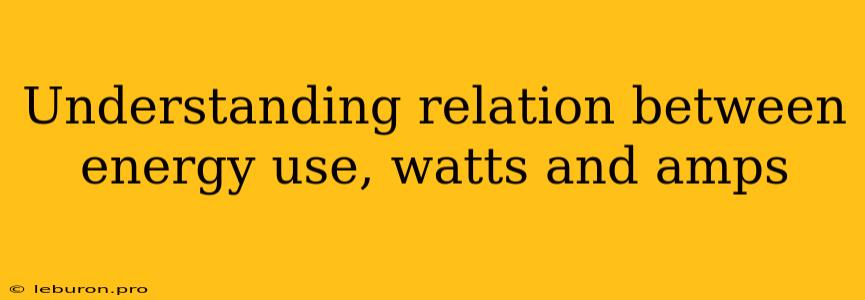Understanding the relationship between energy use, watts, and amps is essential for anyone who wants to make informed decisions about their energy consumption and costs. While these terms are often used interchangeably, they represent distinct concepts and have a direct impact on our daily lives. This article will delve into the fundamental concepts of watts, amps, and energy use, exploring their relationship and highlighting the significance of understanding them.
Watts: The Power of Electricity
Watts (W) represent the power consumed by an electrical device. It measures the rate at which energy is used, essentially how fast a device converts electrical energy into another form, like light, heat, or movement. A higher wattage indicates a higher power consumption, meaning the device uses more energy per unit of time.
For instance, a 100-watt light bulb consumes 100 watts of power when it's turned on. This means that the bulb uses 100 joules of energy every second.
Amps: The Flow of Electricity
Amps (A), also known as amperes, represent the amount of electric current flowing through a circuit. It measures the rate at which electrical charge moves, essentially how many electrons pass a given point in a wire per second. The higher the amps, the more electrical charge is flowing.
Think of it as the amount of water flowing through a pipe. A higher amperage is like having a wider pipe, allowing more water to flow through.
The Relationship Between Watts, Amps, and Voltage
The relationship between watts, amps, and volts is expressed by the following equation:
Watts (W) = Amps (A) x Volts (V)
Volts (V) represent the electrical potential difference between two points in a circuit. It essentially measures the "push" or "force" that drives the electric current. A higher voltage means a stronger "push" on the electrons, resulting in a higher current flow.
This equation highlights the fundamental relationship between these three units:
- Watts represent the power consumed by a device.
- Amps represent the amount of current flowing through the device.
- Volts represent the electrical pressure that drives the current.
Energy Use and its Impact
Understanding the relationship between watts, amps, and volts is crucial for understanding energy use, which is measured in kilowatt-hours (kWh). One kWh is equal to using 1000 watts for one hour.
Your electricity bill is based on your total energy consumption, measured in kWh.
Here's how watts and amps influence energy use:
- Higher wattage devices consume more energy. This means they will use more electricity per unit of time, resulting in a higher electricity bill.
- Higher amperage can lead to higher energy consumption, but it's not a direct relationship. The amount of energy used depends on the wattage of the device and the time it's in use.
Practical Examples
Let's consider some practical examples:
- A 100-watt light bulb uses 100 watts of power. If it's left on for 10 hours, it will consume 1 kWh of energy (100 watts x 10 hours = 1000 watt-hours = 1 kWh).
- A 1500-watt hairdryer uses 1500 watts of power. If it's used for 30 minutes (0.5 hours), it will consume 0.75 kWh of energy (1500 watts x 0.5 hours = 750 watt-hours = 0.75 kWh).
Energy Efficiency and Conservation
Understanding watts, amps, and their relationship to energy use is crucial for promoting energy efficiency and conservation.
By choosing energy-efficient appliances with lower wattage ratings, you can reduce your overall energy consumption and lower your electricity bill.
Moreover, using appliances more wisely, such as turning off lights when not in use, can significantly reduce energy consumption.
Conclusion
Understanding the relationship between watts, amps, and energy use empowers us to make informed decisions about our energy consumption. By recognizing the power of each device, the flow of electricity, and the electrical pressure driving it, we can better understand how electricity is used and take steps to manage our energy consumption responsibly. By choosing energy-efficient appliances and practicing energy conservation techniques, we can reduce our environmental impact and save money on our electricity bills.
